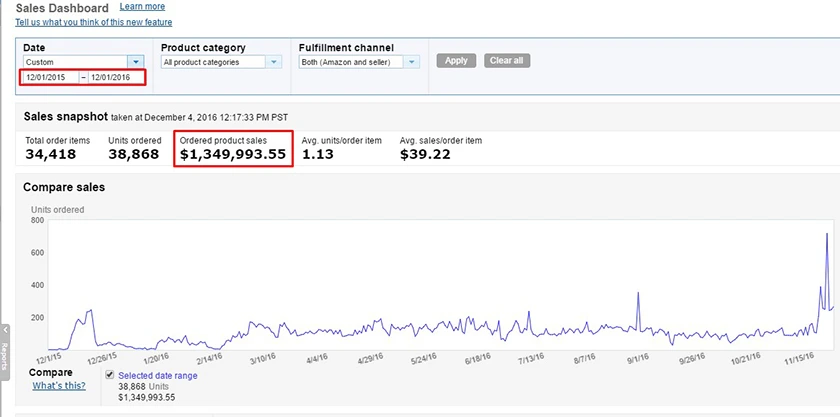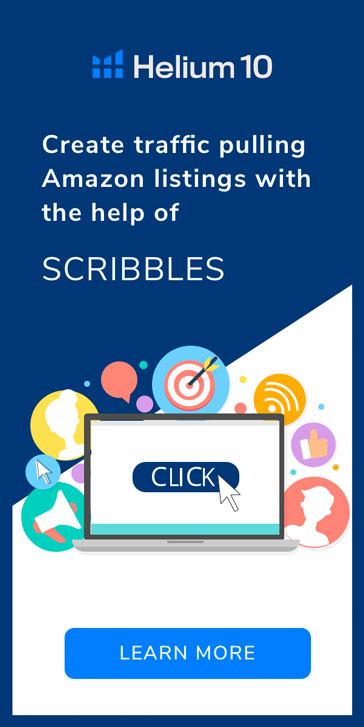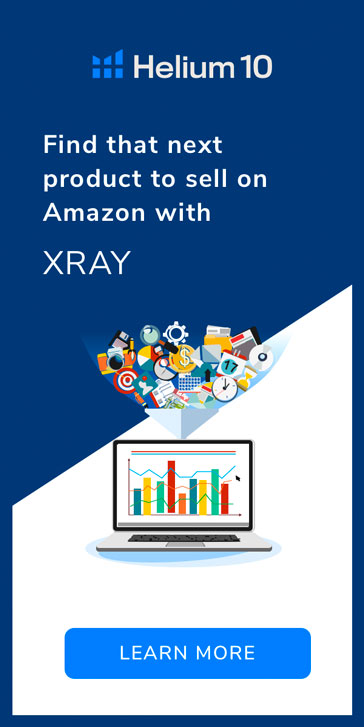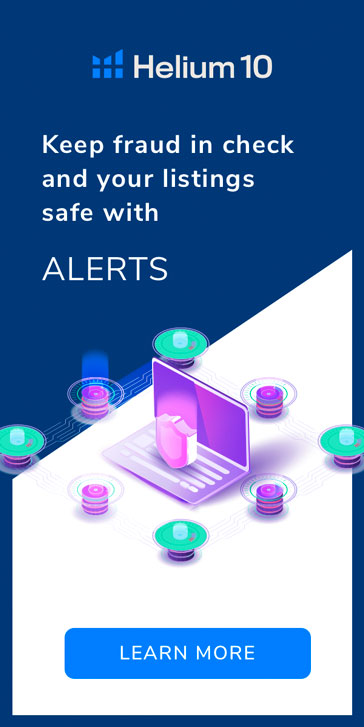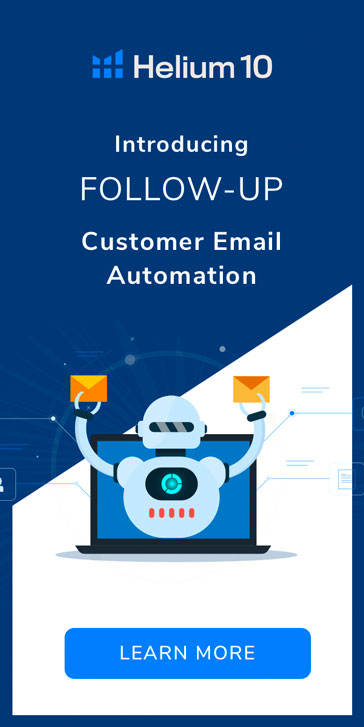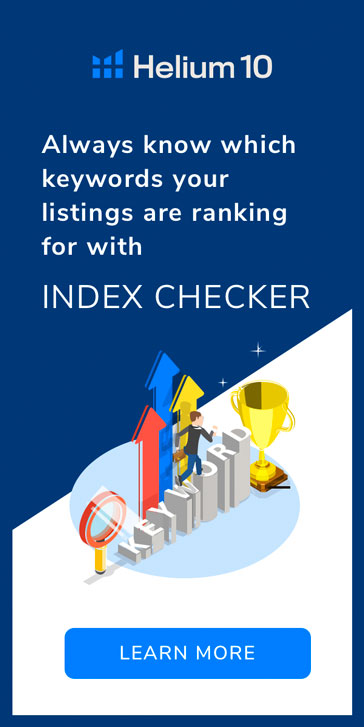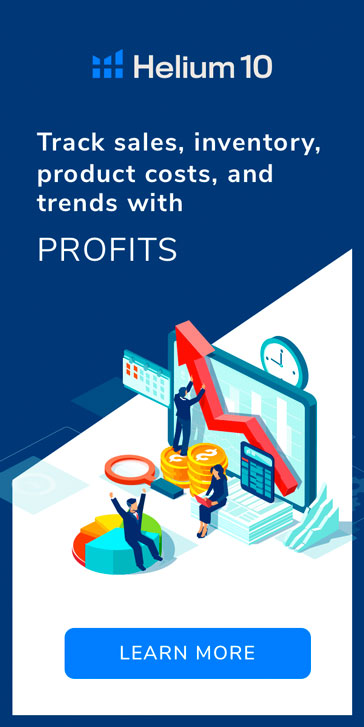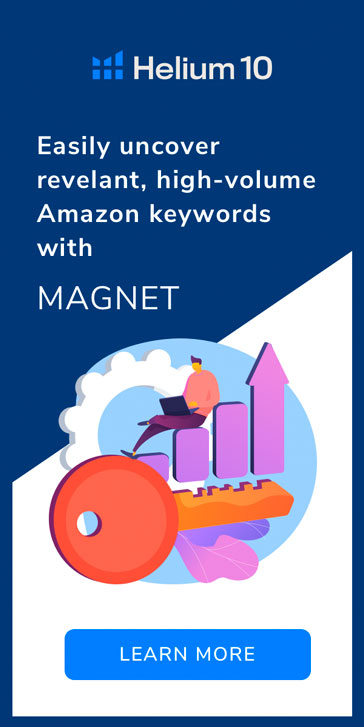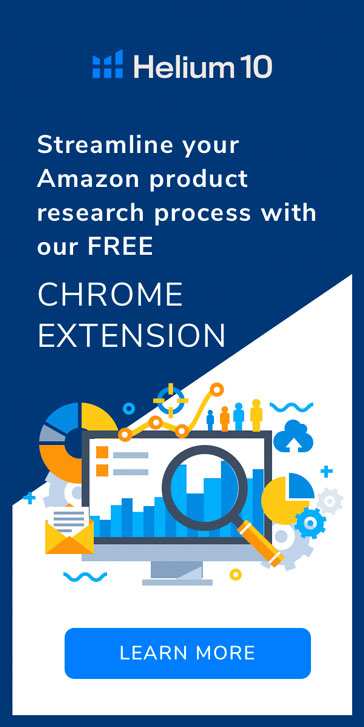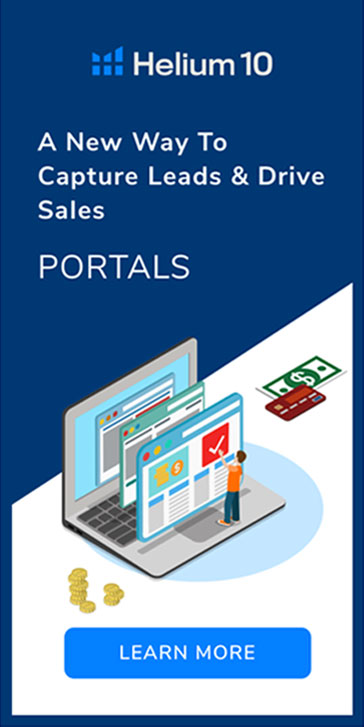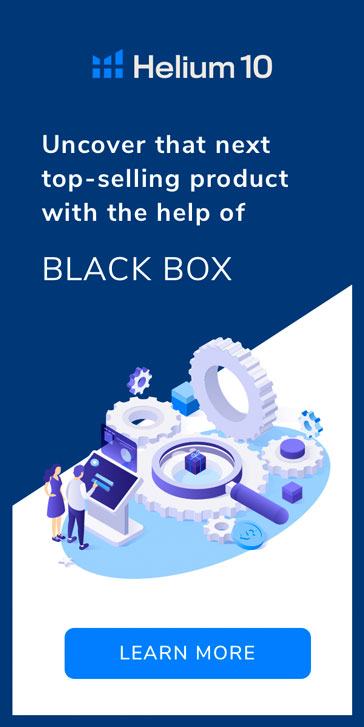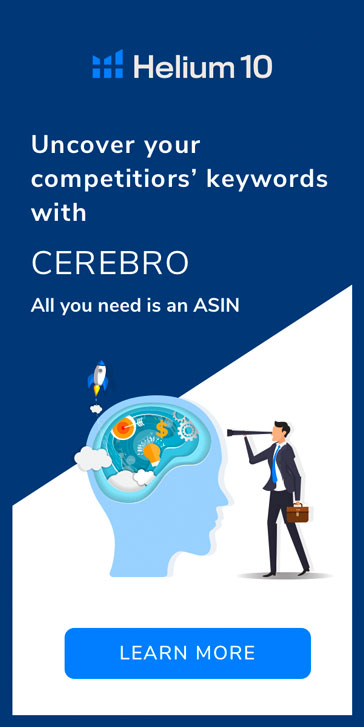It’s been one year. One year since I transitioned from mobile apps and went to a full-time private label seller on Amazon. And wow, what a journey it has been.
My name is Manny Coats, and I am the host of the AM/PM Podcast, founder of Helium10.com, and a FBA Private Label seller like you.
$1.3 Million in sales on Amazon is what I generated during these 12 months, from December 1st, 2015 through December 1st, 2016. And that doesn’t include revenue from other Amazon sources like Merch by Amazon. I have multiple sources of revenue coming from Amazon, but this revenue was generated only on my Private Label business, and 100% of it through FBA.
My Merch by Amazon business is another source of revenue that is not included in the above graph. For the trailing 30 days (November 5th through December 5th, 2016) I have generated $16,793 in sales, of which $6,372.56 gets deposited into my bank account by Amazon. This number is slightly inflated due to high volume days on both Black Friday and Cyber Monday which hit during the final week of November.
December for Merch by Amazon looks to be the best month ever since starting the program back in November of last year. Here are the last 7 days of sales for Merch.
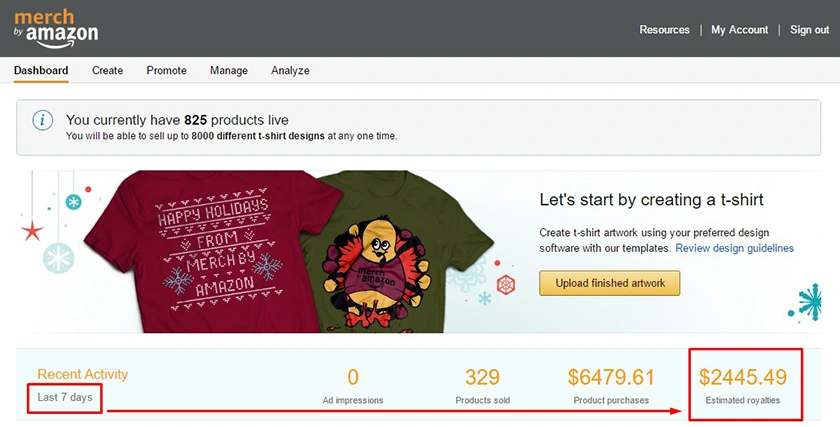
You can see that if things continue as they are, the month of December could hit $8,000.00 or more in profit from the Merch program alone. What a fantastic program Merch is.
Pivoting the conversation back to Private Label with FBA, it should be mentioned that while I have hit the 12 month mark since going full time with FBA, there’s still one month left to complete a calendar year. My total sales for the entire 2016 year should be closer to $1.5 million when all is said and done.
As I reflect back to the episode #1 of the AM/PM Podcast, I remember it clear as day, the goal I set for myself, and the fact that I was announcing it publicly for all to hear:
“My goal is to generate $250,000 in sales by the end of the first year.”
I remember at the time, thinking how big that number seemed to me for a marketplace I had almost no experience with. I was worried about making that goal public. I hadn’t seen anybody do this for Private Label, at least not somebody that would be in the lime light. But I am glad I did, as it forced me to hustle and grind and push beyond the limits of what I might have otherwise done. My favorite quote for now, and one that I live by is, “You miss 100% of the shots you don’t take.”

By the end of December 2015, I was already more than a quarter of the way to my publicly announced goal. I was already practicing my ‘$250K club’ acceptance speech.
Fast forward one year, and not only did I achieve, and in fact crush the $250,000 goal, but I have now made another public announcement in our FBA HIGH ROLLERS GROUP that my goal for the month of December, 2016 is to hit $250,000.
To be crystal clear, I want to generate $250,000 in sales in one month. Will I do it? I think so. All the pieces of the puzzle are in place, and I have been planning for December for the past few months. A little Empire strikes back inspiration should get me there – “Do or do not. There is no try.” – Yoda
What a contrast, right? One year ago, I wanted to sell a quarter million dollars in sales in one year, and now, as I hit the one year anniversary of my private label business, I want to sell a quarter million dollars in one month.
Keep in mind that December is a high volume month, so that makes it easier, and I know this. That is why I am setting such a lofty goal. More than doubling my average monthly sales number in one given month is not a number I just plucked out of thin air. Based on the data that I see, it should happen. We will all know in about a month when I update my earnings reports on the AM/PM Podcast.

Today however, I want to talk specifically about the month of November – it’s such an important month that in the USA it contains the Thanksgiving holiday, Black Friday, Cyber Monday, and kickstarts the Christmas shopping season.
Specifically, I will be talking about what my numbers looked like, and what my successes and challenges were during this time. A lot happened, so let’s get into it.
HOW MANY SALES DID I MAKE IN NOVEMBER?
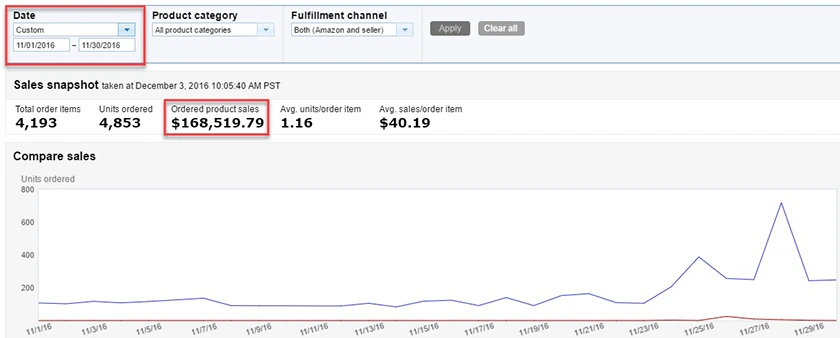
My overall sales for the month of November, 2016 were $168,519.79.
These numbers were elevated due to Black Friday (November 25th) and Cyber Monday (November 28th.)
Leading up to Black Friday, my average sale day for the trailing 7 days was $4,169.57. But then on Thanksgiving day (November 24th,) surprisingly, sales shot up. I thought Thanksgiving would be a slower day, followed by a hectic one the day after, known here in the USA as Black Friday.
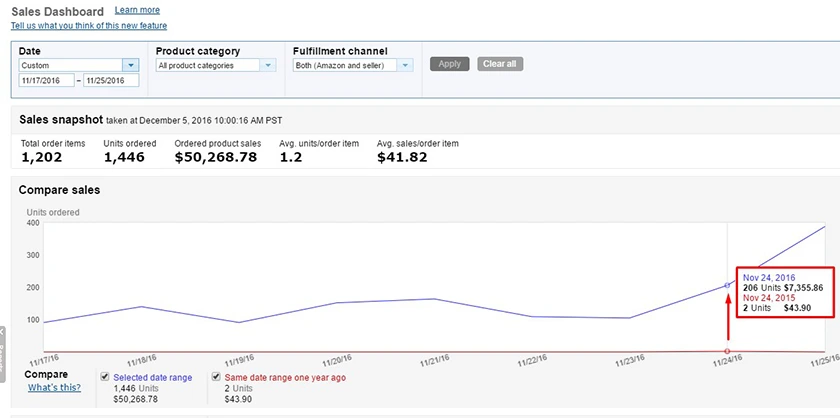
But as you can see from this graph, sales jumped to $7,355.86 on Thanksgiving day. What a nice surprise! However, you have probably already noticed the graph is on an upward trend as it reaches out to November 25th, the mother of all sales days, Black Friday. Let’s take a look at the sales on this date:
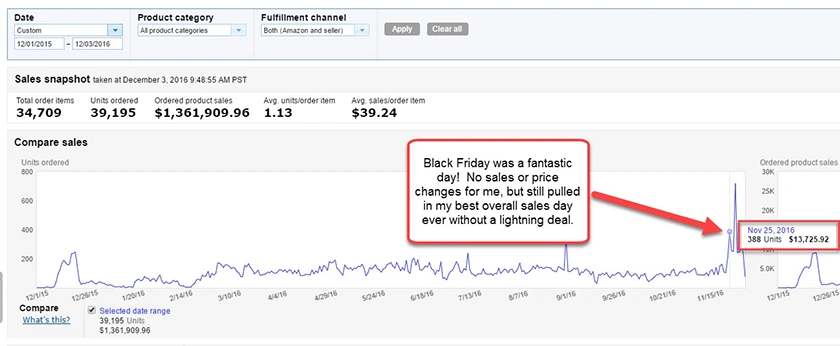
Sales were up by nearly $10,000 on that day over my previous daily averages the week before. $13,725.92 in a single day, and this was done without a lightning deal or any price adjustments to my products. That’s right – I didn’t lower my prices for Black Friday.
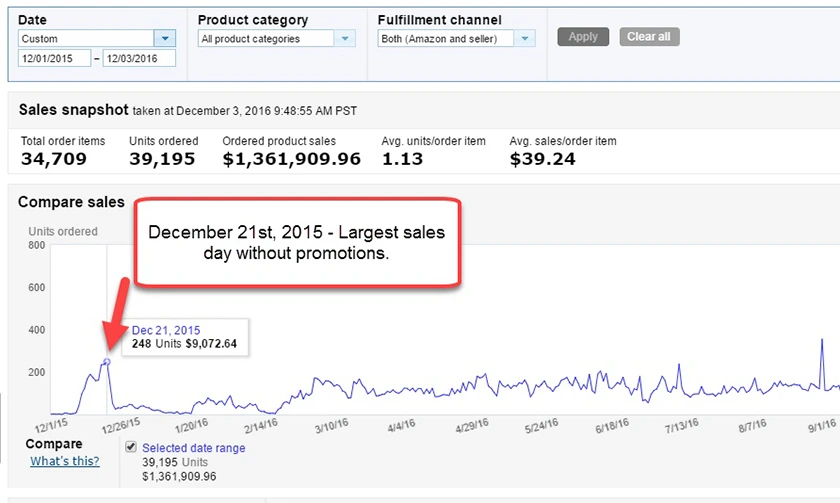
Up until this point, December 21st, 2015 was my largest sales day ever in terms of pure sales with no lightning deals. I remember doing a special money-dance that particular day as I broke past $9,000.00 in sales.
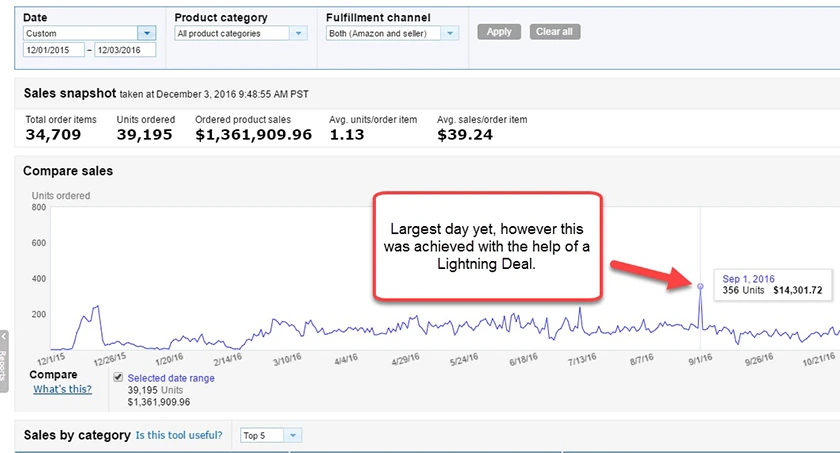
My overall largest day ever was a lightning deal day on September 1st. On that day, I was able to crush my December 21st sales day with a whopping $14,301.72 in sales. The heavyweight championship belt now belonged to this day. Would it last? Read on.
Cyber Friday was fantastic, and close to breaking my overall sales record even without a lightning deal. Saturday and Sunday were very nice days as well, both weighing in at around $9K each in sales for the day.
This was easily going to be the best overall week in sales since starting my Amazon business.
Here’s where it gets interesting, and surprising at the same time.
It was Cyber Monday. My first ever Cyber Monday on Amazon. Remember, I had started my FBA business back in December of last year, so selling on all of these November holidays are brand new to me.
I wake up to start my week – It’s Monday morning. I start making my coffee. As I am pouring myself a cup, I pull out my cell phone and fire up the Amazon app to check my morning earnings – a ritual I share with many of you reading right now.
My eyes open up wide, jaw falling open. My sales were at $4,300.00 and I was just starting my day. I wasn’t even fully dressed yet. It was only 8am and I had already made more sales than the entire day of the previous week.

In just one hour, from 7am to 8am, I had sold $1,534.00 in sales! My facial expression morphed from shock to huge smile.
As the day progressed, sales kept coming in, climbing, until about 9pm at which point sales finally slowed down. What were the results for the full day?
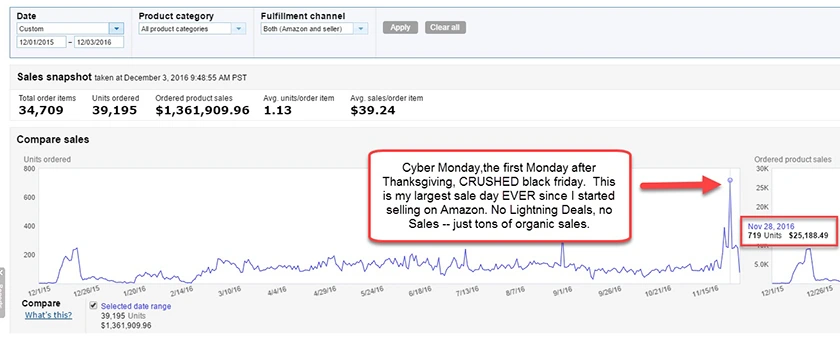
$25,188.49 in one day. Nearly 6X the normal daily sales, and almost 2X more than Black Friday. This was a new daily record, regardless of promotions or not. And in this case, there were no discounts or promotions being run. I grabbed another coffee cup and toasted myself in celebration.
Surely I was ramping up my sponsored ads, right? No… not right. I didn’t change my sponsored ads. Everything ran as normal. You can see from the image below that sponsored ads spend did go up daily starting Black Friday, but that was just from increased traffic to Amazon and a portion of that traffic getting impressions from the campaigns that had always been running.
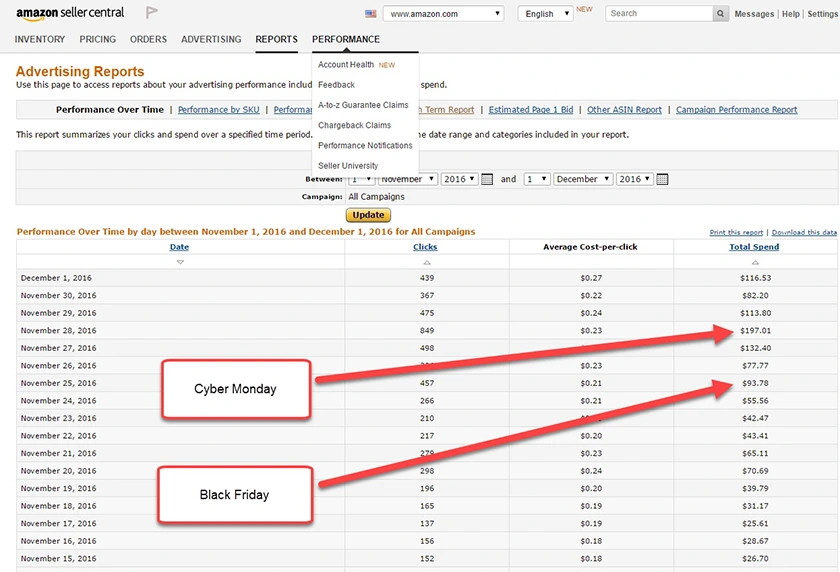
Sponsored ads spending went up by about 4X for a short while, and is now hovering around 2X since December started. But that’s just because of traffic, not from anything I did. These numbers coincide with my other data where overall traffic to my listings have more than doubled since the Holiday shopping season started.
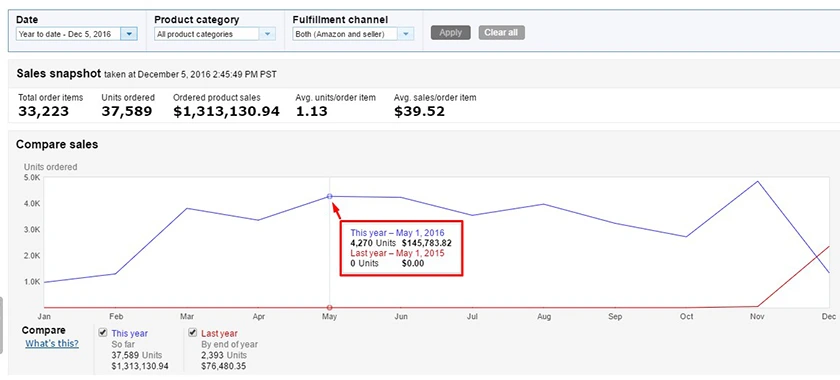
I haven’t done any income reports in a while, so let us do a Michael Jackson moonwalk back in time to my 2nd largest month behind November… May, 2016. Total sales revenue reached $145,783.82. May through August was pretty steady, and then I took a slight dip in the months of September and October for a number of reasons that would keep MacGyver busy, so we’ll save those stories for later.
OTHER COSTS
Back to November. I’d like to mention a few other factors that pulled down my overall profits.
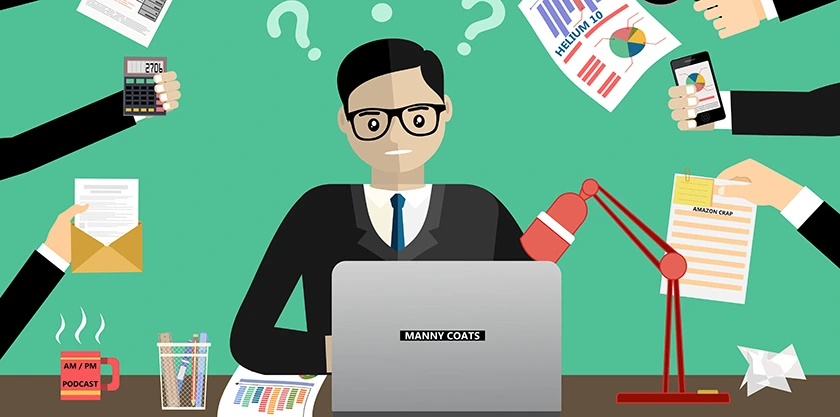
It’s important to include these things, and I see people so many times not factoring in all their costs, and then wondering why their bank account is as empty as a hermit’s address book.
Promo Codes: I had 20 promo codes used last month. I was testing out a strategy to liquidate one brand I am going to abandon, and it involved promos. This didn’t affect the bottom line very much.
Returns/Refunds: I had a total of 80 refunds or returns. With over 4,800 units ordered in total, this puts my overall refund rate around 1.7%, accounting for less than $3,000 total.
Shipping costs were much higher than normal. Due to timing of some investment capital, and wanting to ensure that the product I purchased with that capital arrived at amazon fulfillment centers in time for the holiday, I express air shipped some very large quantities of products (more than 20-foot-containers worth.)
The good news is that the products did make it in time, and as I write this article, my final shipment of one product arrived and is being received into the warehouse today.
So the big question I am always asked… “How much profit did you make?”
My profit Margin was almost 25% on the dot. Just over $42,600.00 pre-tax revenue. Pretty solid for a single month.
REVENUE PER BRAND
I currently have four brands, 3 of which I am actively building. The 4th brand I am phasing out. I actually used that brand to apply for Vender Central. So for all intents and purposes, I have 3 active brands.
59% of my revenue currently comes from one brand. 41% comes from my two other brands. To make things worse, one product in my top brand generates the majority of the revenue for that brand. This is the result of me focusing very heavily on the one brand and one product and trying to find the limits to how many sales I can generate with it.
I am taking big steps to even this out moving into 2017. The good news is that I was planning on selling this brand in 2017, so this definitely has driven up the value.
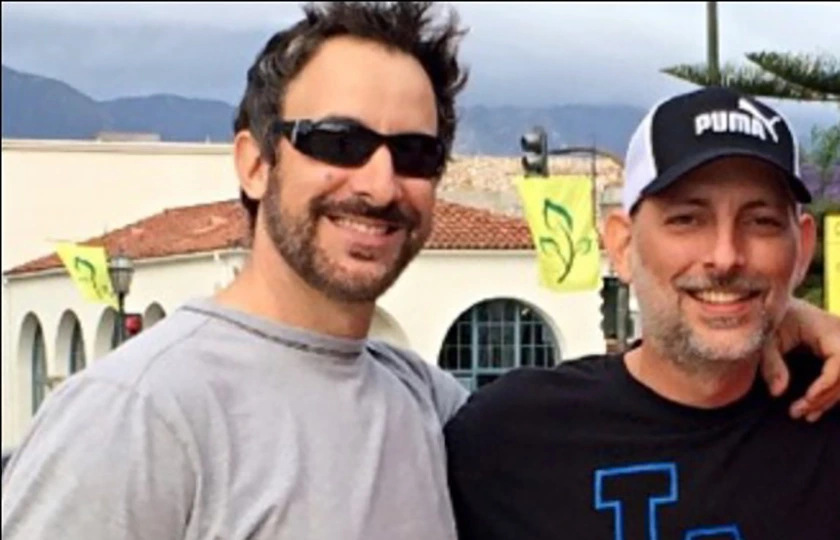
The photo may be blurry when blown up to this size, but what’s not blurry and is totally in focus is our mission to grow like gangbusters in 2017. My brother Mike, seen above on the right, was heading up the Merch by Amazon program, but to really capitalize on the program, we’re waiting on Merch to open up advertising opportunities. Once they do that, we should have a massive advantage over most sellers currently in Merch.
Until that happens, Mike has put Merch on autopilot and has come over to help alleviate some of the chaos I am now dealing with on the FBA side of things. Fourth quarter gets hectic – very hectic. We have to forecast sales to make sure we have enough inventory. We have to balance speed of product delivery with landed cost, to ensure we are still generating a decent profit when all is said and done.
Dealing with suppliers, freight forwarders, and customers who are buying the products, is a full time job. Researching new products and creating new listings all but ensures the day will be a full and busy one. Mike handles this for me, freeing up time to work on the marketing side of things, which is what I really love to do.
HOW DO I GET BRAND GATED?
While my brother Mike is finding us new products to sell, I’m working on getting them brand gated. You may not have heard, but brand gating is one of the biggest pieces of news to roll out on the Amazon front in a while.

One of biggest pieces of news to roll out on the Amazon front was the announcement that Brand Gating was now being offered to smaller brands. Not to be confused with Brand Registry, Brand Gating is the ability to restrict any other seller from being able to sell your product under your brand.
Isn’t that what brand registry is? The answer is NO. Brand Registry allows you to control the editing of the listing content. This will keep a hijacker from changing your title, bullet points, and description. But anybody can still come onto your listing and sell a product so long as it’s the same product.
The issue with this Brand Registry is that too many Hijackers sell counterfeit products, so they can easily come onto your listing, underprice you, and take away the buy box and your sales. Amazon makes you go through the hassle of reaching out to the other seller either via a ‘cease & desist’ notice or having to order the hijacker’s product so that you can prove it is in fact a counterfeit product.
With Brand Gating, all of that goes away. As soon as another seller tries to list their product on your listing, they will be in for a sad surprise, as Amazon alerts them that they need approval to list in that brand.
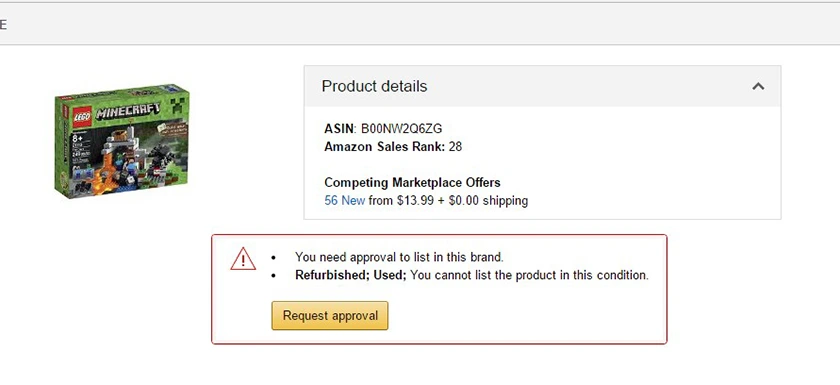
The nice thing about Brand Gating is that once you get it for your brand, all your products under that brand are now protected.
There are various levels of brand gating. Fully gated means that nobody call sell on your listing, regardless of whether the product is NEW or USED. Some brand gating restricts only NEW products, but allows sellers to still sell USED versions.
Amazon has recently been auto-gating some brands, and a few sellers in our FBA HIGH ROLLERS GROUP have stated that some of their brands are now gated.
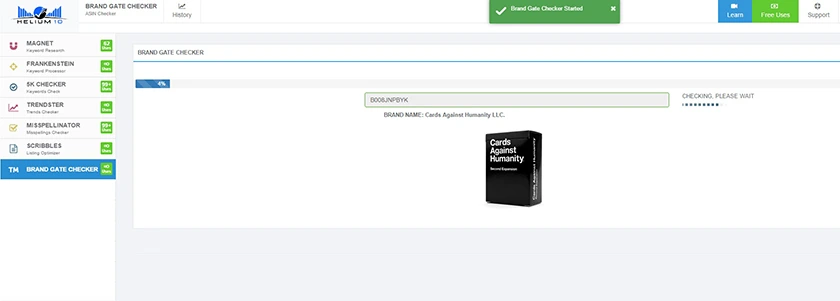
We released a tool in November called BRAND GATE CHECKER that allows you to check if your brand is actually gated or not. It’s a free tool for everybody to use.
If you find that you are not gated and want a professional private label attorney to handle your account to get you gated, I very highly recommend the services of Attorney Suzi Hixon. Her rates are $2,000 per brand (prices increased from $1500 on December 5th,) but we’ve negotiated a special rate for our readers that is heavily discounted, and added another $1,000+ in free bonuses if you hire her through BrandGating.com
BrandGating.com is a collaboration between Suzi Hixon and our company to bring you incredible value. How valuable is brand gating? Let’s just say that I lost over $36,000 in sales this year from hijackers stealing away my buy box. This wouldn’t have happened if my brands were gated. I have Suzi Hixon working on Brand Gating all of my brands.
BRAND NEW FACEBOOK GROUP: MERCH ELITE
One of the largest Amazon Private Label groups online is called the Amazon FBA High Rollers group. With nearly 14,000 members at the time of this article, the group is arguably one of the most active Amazon Seller communities on Facebook. If you’re not already a member, go join right now.
With Amazon’s Merch program, I wanted a place where people who were interested in learning more about it, could go to really focus on it. Posting about Merch in the FBA High Rollers Group would quickly have that message buried in the deluge of FBA messages posted daily. I wanted something more focused on just the Merch Program.
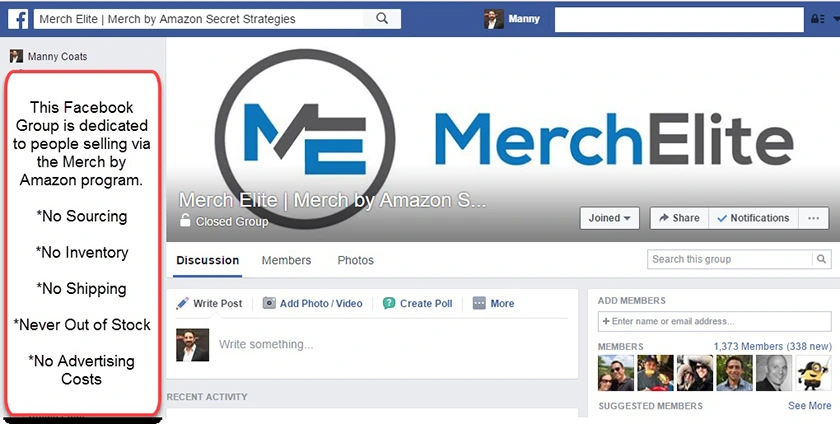
That’s when the MERCH ELITE group was born. With nearly 1,500 members at the time of this article, it’s quickly gaining traction.
It should be mentioned that Chris Green also has an excellent group called Merch by Amazon, and if you’re interested in Merch, you should definitely check that out. Even though Chris’ group is amazing and I am often in there chatting with Chris and others, I wanted a group of our own that I could moderate and that was a direct extension of our Amazon FBA High Rollers group.
MY ARTISTS ARE AVAILABLE TO YOU
In addition to creating the MERCH ELITE group, I also made available to everybody the artists that I use to create all of my shirt designs, as well as all my packaging designs for my FBA business.
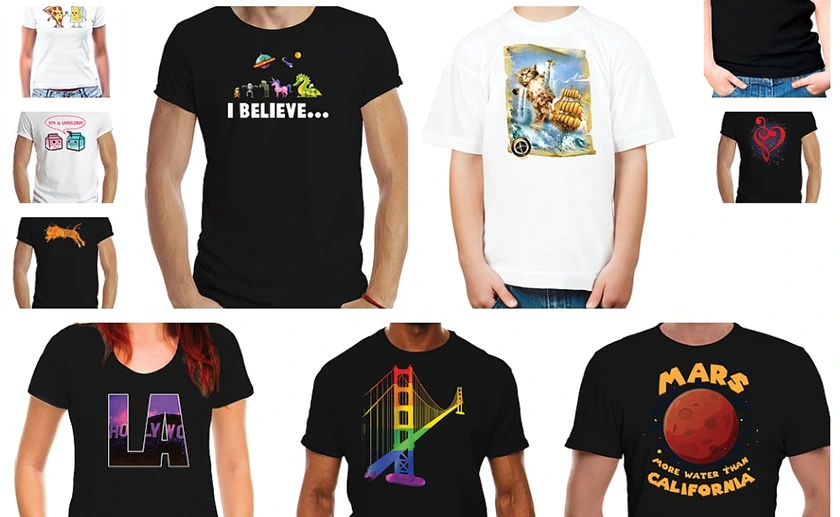
These guys are the best of the best, and I have been using them for years, dating all the way back to when I started making mobile games. They are under strict NDA and will never discuss any of your designs with anybody. I’ve even told them to never show me or talk to me about what they work on with clients. Believe it or not, that is a fact. Definitely check them out.
Dan, the manager of the team, set up a site for you to check them out at: MERCHARTISTS.COM (Service no longer available)
AMS (ADVERTISING MARKETING SERVICES)
I have podcasted about it, but I am guilty of not actually employing the tactics I have learned. Not because of not wanting to, but simply because it was on a long list of to-do items, and I never got around to it. I use Simpleology to keep track of what I need to do, and the list continually gets longer, not shorter. I’m sure many of you reading this now can relate.
Now that my brother has taken a large load off my plate, November was the month I finally put my Vendor Central account into use and am running various AMS tests to see what is working and what is not. It’s only been a few days so far and the results are interesting to say the least.
There is so much you can do with AMS and I am just scratching the surface, but idea-lightbulbs are already flickering to life in my head on ways to use as a serious money-maker. Let the testing begin!
VIRTUAL ASSISTANT
We went through a few VA’s, but our new V.A. we hired in November is doing great and taking on a lot of responsibilities. Our mission over the next few months is to now outsource everything we can. We’ll be bringing on several new people that will handle important portions of the business, to help grow the company even quicker and optimize profits.
SUPPLIER CREDITS
One thing I have started enforcing in November are supplier credits. When a customer returns or refunds one of my products due to it being defective, I keep track of this. I’ve been doing so for a while now and in November I hit my largest supplier up for all the returns for the entire year.

They were not thrilled, but I had been telling them since day one that I would need credits for any returns that were due to product defects, and they had agreed to that.
I probably shouldn’t have waited so long and dropped several hundred units on them at one time that needed replacement. But they finally agreed to it and I now get a few hundred extra units for free on my next shipment.
If you are not doing this, you should be. Make sure you put this on your purchase orders so that they can never back out of it.
CASH FLOW
One of the things I quickly found out about this business is that if you don’t have a nice bank account, it’s hard to grow your business.
You’ve likely heard the stories of a successful Amazon seller who started with $200 and are now selling 6 figures per month. While it may be true, it is certainly not common, at least not any more.
Several years ago, the number of Amazon sellers was vastly lower than what it is now. Just about anything you threw up on Amazon would sell.

You could literally climb the stairs of success with almost no experience, an average product, and a halfway decent listing. You had very little competition, so your prices could be maintained at a higher level, ensuring solid profits.
Many of the sellers who started out with very little money several years ago were selling supplements. What you might not know is that the cost of goods for most supplements is incredibly cheap. When I was in the supplement business many years ago, we could manufacture and bottle a particular cleansing product for under $3 and sell it for $60. Talk about incredible profit margins! The products are small and light, so the shipping costs were incredibly low. Our cost of goods was less than $10, and that included the shipping fees to get the product to the customer.
Making our sales even better, people would often times come back and order more of the same product in subsequent months, or buy several bottles at a time. With $200, I could create and ship out 20 orders, which would make me $1,200 in sales. With $1,200 I can now ship out 120 bottles which would make me $7,200.
I know I am simplifying it massively and leaving out various costs, but following the same math, if I didn’t pull money out of the company, and I could sell every unit I made, by the time I sold my 4th batch, I would be up to 6 figures in sales. It would be pretty easy to do 4 full shipment cycles per year, even if each one took 90 days.
Those days are mostly gone. If you have a supplement that is costing you $3 per bottle and you sell it for $60, you’ll almost certainly have 20 other sellers undercutting you very quickly, and soon after that undercutting each another. Every detail of your product, marketing, and your competition, is critically important now. One misstep, and you could be done for.
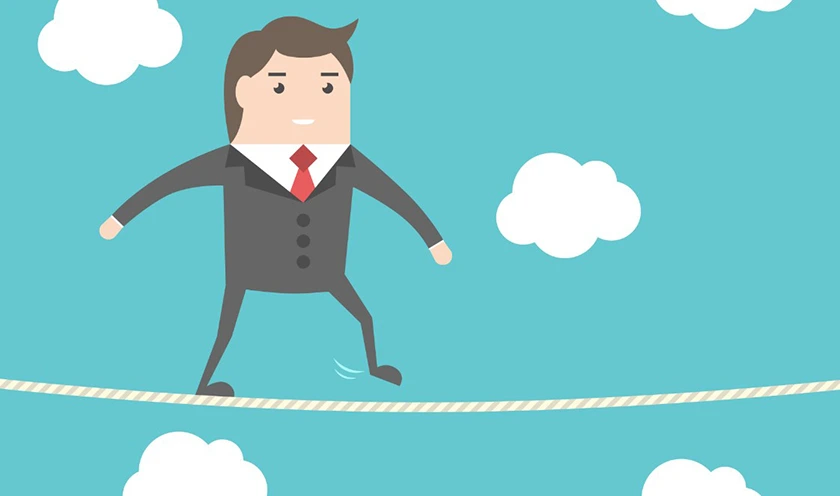
The stairs of success have been replaced with the tight rope of perfection. The days of turning $200 on Amazon into a 6 figure business are incredibly rare.
If you’re reading this right now and you started with $200 and turned it into a solid business without investing additional capital other than what you were earning from that original seed investment, please reach out to me, as I would love to have you on the AM/PM Podcast to share your motivational story. You can leave me a voice mail message HERE.
Starting with a decent bank roll allows you to grow much more quickly. I know, because my growth rate has been severely hampered by a lack of funds. Even though I generate 6 figures per month, I reinvest every bit I can back into the business so that my next order can be larger. Even if demand is there and I can sell more, I can only buy so much. My Chinese suppliers are not the ‘credit giving’ type of folk.
Once I max out the number of units I can sell in a given month on Amazon due to demand (i.e., I can buy more than I can sell), I then expand out to variations of that product or similar products. That requires money. So I start with 1 product, build it up to the limit on Amazon, then repeat.
But if I had access to additional capital, like a loan, then I could expand out into multiple products more quickly, or ramp up my current product faster, or expand out into different Amazon stores or even other markets like Walmart.
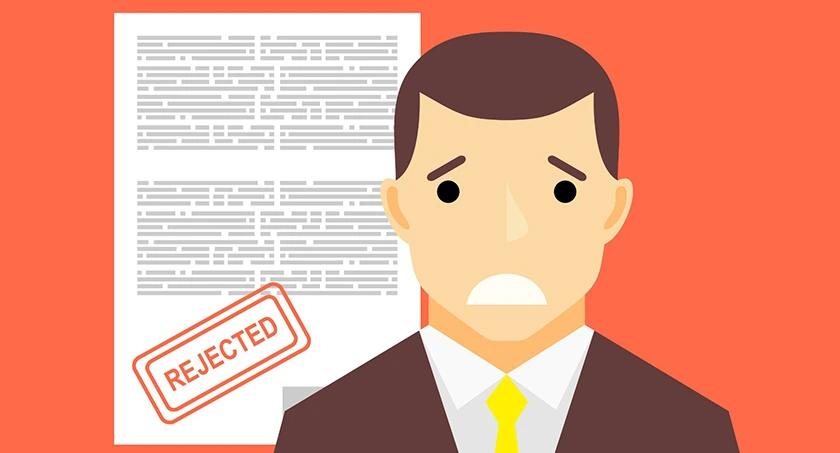
The issue for me has been the fact that my business was started a year ago. During the entire year of growing this business, no lending institution wanted to work with me.
“Can we see the last two years of your Tax returns?”
“What kind of profit did you make last year? Can we see your P&L statement”
Of course I didn’t have tax returns yet. And I wasn’t making a profit, as I was reinvesting everything back into the business. So what is one to do?
Amazon Loans! Well… not really. Amazon gives loans to sellers, but only after you’ve been selling for a year. Speaking of which, I’m now at one year and I don’t see a loan offer from Amazon.
So what now? Luckily, I have a happy ending to my funding woes. And it all happened by accident. Here’s how it went:
I attended an Amazon conference in Los Angeles. At this conference, the attendees were asked to sit at large round tables that would seat 6 to 8 people. I happened to sit next to a guy that was very friendly and as he glanced at my name tag, he recognized me as the host of the AM/PM Podcast. He introduced himself to me. Will Moffet.
Will Moffet worked for a company called Bonolo. Later they would change their name to Upfund. Will told me about their business and how they are fulfilling a need where Amazon sellers who are on the uptrend with their products can get crowd funded, and not be required to have at least one year of business history. Very interesting!
I applied for the service, and then I discussed the results on episode #84 of my podcast where I bombarded Will Moffet with question after question about their service. If you haven’t listened to one of my podcasts, just know that during my interviews, I like to ask questions as if I knew nothing about the person or business they represent.
Long story short, using Upfund, I was able to get funding for the first time on my Amazon business.
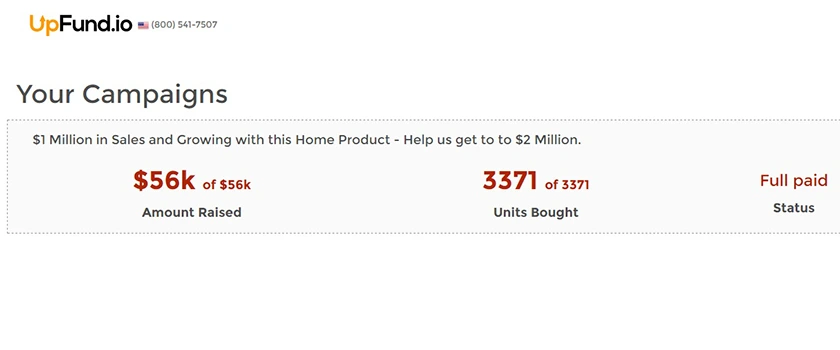
As you can see from the screen capture above, I raised just over $56K in 2 weeks, and I used that money to purchase extra inventory for Christmas as well as expand out to additional new product lines in one of my smaller brands.
I’ve added 3 new products to one of my brands for December, and I have one additional product coming for this brand in January.
I’ve also ordered some samples of additional products for this brand, and if all goes well next week after reviewing them, I’ll be adding at least 4 to 6 new products to this brand during Q1 of 2017.
Will Moffet and I worked out a fantastic discount for all readers. If you sign up using the link below, you’ll get 10% off on their loan origination fees. You won’t get this if you go direct. It’s our affiliate link, but the discount was negotiated due to our high volume of active users. Sign up today: Upfund (10% Discount on Origination Fee – Click Here.)
FEEDBACK RATE:
My feedback rate for November is 2.91%. This means that 2.91% of the people that purchase my products are leaving me seller feedback. Typically, I am at about double this number each month. I think there are two reasons why the number is lower than normal.
1) Customers are getting hit pretty hard via email by sellers ever since incentivized reviews have been banned by Amazon.
2) November just ended and most of my email follow-up campaigns last about 10 days. So there are still a good number of customers that have not gone through my entire follow-up sequence. In fact, the majority of customers that purchased my products on Cyber Monday have not yet received the email that asks them for seller feedback.
HOW MANY EMAILS DO YOU SEND TO CUSTOMERS?
It would be ungentlemanly of me to talk about feedback rates, which I get by sending out emails to my customers, and not at least answer one of the most common questions I get about the topic which is: “How many emails do I send out to them after they buy my product?”
The answer is… it depends.
What I do with my follow-up email campaigns isn’t static. I’m always adjusting based on the data. To simplify things for this article, I can say that the majority of my products start out on a three email campaign.
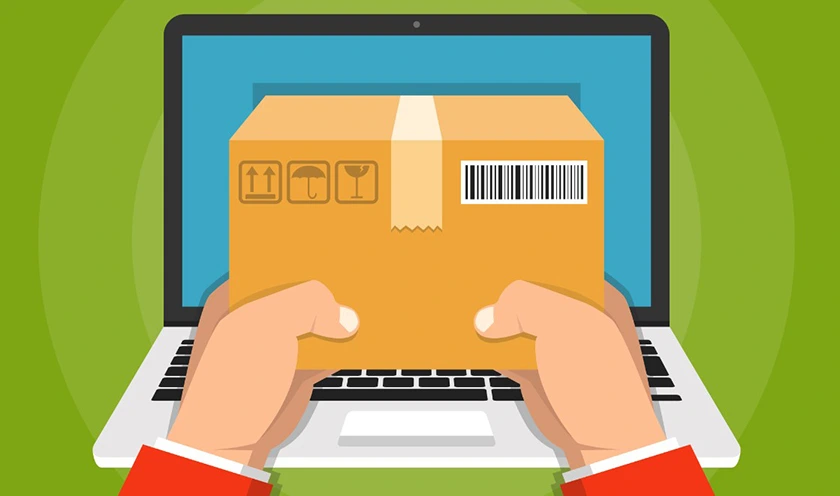
Email #1 – I send this 2 days after the customer has received the product.
Email #2 – I send this 5 days after the customer has received the product.
Email #3 – I send this 10 days after the customer has received the product.
Email #1 has no pitch. I don’t ask the user for anything other than to reply to my email and let me know if the product arrived OK. I want them to reply and get dialog going with me, even if the reply is just a YES or a NO.
I also start dropping a seed in their mind about my product being a 5 star product. I’m not violating any TOS because I am not asking for any reviews. I have many different ways of getting the user to engage with me on the first email, but one might be:
“Please hit REPLY to this email if you feel my Yo-Yo isn’t a 5-star product, and let me know why.”
Most people won’t reply and tell you why it’s not a 5-star product. But I do get a lot of replies confirming they love the product. Those are the people I want to be communicating with anyway.
The important part here is that I have created dialog with the user. There’s a connection now. And this will make my future emails 10X more powerful than they normally would be.
Wait… what? What do you mean, Manny?
Think about this way. Imagine you are at a convention and you don’t know anybody. Somebody walks up to you and says “Hello” and asks you how you’re enjoying the conference. After you respond, they give you their name and say they are on their way to a meet somebody, but it was good to meet you.
Now imagine on day 2 of the conference, you happen to run into this same person at the hotel bar. Are you not 10X more likely to initiate conversation with this person or respond more kindly to whatever they say to you if they start the dialog? This is the mindset I am after with my users, and it WORKS!
My 2nd email asks them for a review. I say it in a very nice way and ask it as a quick favor. None of my emails are very long, as people do not want to read a novel. Keep the email down to a length that can be read in under 10 seconds.
My 3rd email asks them for a seller review. I include one sentence that explains the difference between the product review I previously asked for and seller feedback, which is all about me. Remember, these customers like me now. I have a connection.
I will often times flip the order of emails #2 and #3. But using this method gets me tons of reviews and seller feedback. I don’t have a single product that is under 4 stars and my seller feedback is almost perfect with well over 1000 customers taking the time to rate me.

TOOLS OF THE TRADE
I am asked daily, what tools do I use for my Amazon business. And what did I use in November to hit the numbers I did?
I am quite biased, because I built my own tools for the majority of what I do. And later I released those tools to the public under the company: Helium10.com
So there’s a vested interest. No matter what I say, if I mention Helium 10, it comes with a bit of snarkiness from people that know I am the founder of the company.
But those that really know me, know that I don’t BS people. I tell it how it is, and I try to be as transparent as I can. And I use my tools. I also use other tools as well. That said, let me tell you some of what I use.
For keyword research, I use the Magnet tool (Helium 10.) I called it Magnet because just like a magnet, put pulls out or attracts the best keywords. I’m using a beta version which is different than what is live to the public as of December 5th, but it looks like the version I am using will be pushed out to paid members of Helium 10 sometime in late December.
I used to go for massive amounts of keywords, even if barely related, but I have changed this recently to focus on a much smaller number of keywords and try to get the listing super optimized for the phrases that will generate 90% of my sales. For this reason, Magnet is awesome.
For product research, I use a combination of tools, one of which is my own (not available to the public) and Jungle Scout. When it comes to tools like Jungle Scout, all of them do estimations on sales volume, so it’s important to use a number of tools to get a range of data and then make an educated decision based on how you feel about that data.
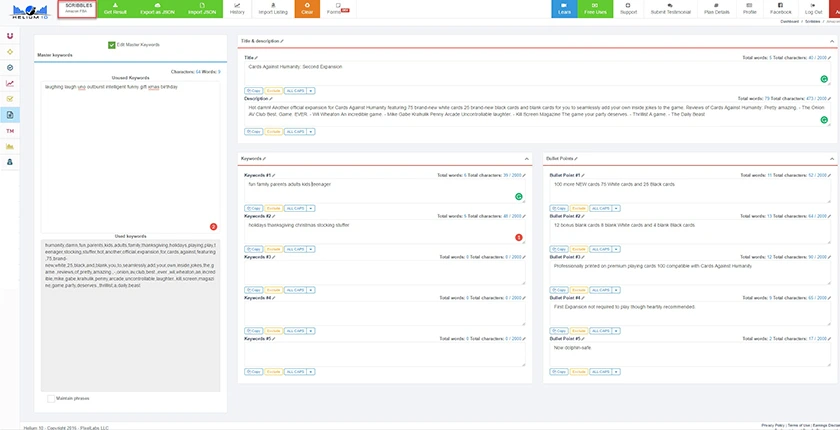
I use SCRIBBLES (Helium 10) seen in the image above, to write all of my listings, and it is used very heavily in conjunction with FRANKENSTEIN (Helium 10) to manipulate the keyword phrases to get the perfectly SEO optimized listing for Amazon. If you’re curious why it’s got the goofy name ‘Frankenstein,’ here’s why: Frankenstein is made up of a bunch of different parts. Individually, they mean nothing. Put together, they complete the creation. The same could be said with keywords. When you start with a bunch of keywords, they don’t mean much. You have to clean them up, filter them, remove duplicates, and arrange them in such a way that when you are done, you have completed your creation. Same as Frankenstein. Hopefully you’ll remember the tool name from now on.

As I close out this article, one thing I didn’t talk about was how my November numbers were affected negatively because of a mistake I made. My best selling product suddenly lost ranking and was de-indexed for a popular keyword. I was not aware that it happened right away because I got lazy with using a specific tool. If you’d like to hear more about what the issue was and how much money I lost and how I fixed it in about 15 minutes, listen to AM/PM Podcast Episode #87.
Manny Coats is the host of the AM/PM Podcast, CEO & Founder at Helium10.com, and an active Private Label seller that generated $1.3 Million in sales in his first 12 months on Amazon.
Original Post from One Year Selling On Amazon – Income Report












